
Feelings Can Be Friends
My book, Feelings Can Be Friends is a great tool for mental health professionals, teachers, day care providers, and parents – anyone who spends time with children. It is a book that can be read to children, or that children who are old enough can read themselves. Children connect immediately with the playful illustrations and can more easily understand the feelings they represent. The text is simple, understandable, and is ‘spoken through the voice of a child.’ It is appealing to all children; those who are typically developing as well as children experiencing a variety of difficulties. The simplicity of the book allows it to be adapted to many uses. I have used it as a tool with individual children, groups, and primary school classrooms. Parents have used it at home, and teachers and mental health professionals have used it in their settings. The book can stimulate discussion, as well as drawing and writing projects for children, depending on their age.
Where did your inspiration for the book come from?
Throughout my career as a Licensed Clinical Social Worker and School Social Worker my mission with children was to help them understand their feelings so they could comprehend their experiences and examine behaviours that were driven by their feelings. Additionally, equally as important, was helping parents to both understand and communicate with their children on a developmentally appropriate level; as a mother myself, I knew how challenging this could be. Over time I found that picture books were great tools to engage children’s attention and stimulate thought and communication. At the same time I found myself creating visual tools to use in my work with children to help them conceptualize abstract concepts, i.e. feelings, that are difficult for them to understand through discussion alone.
Please tell us about your journey to becoming a social worker.
Even as a youngster I always loved children and decided early on that I wanted to work with them in some capacity. As a teenager I volunteered with different children’s groups, and was a babysitter for many families. During college, I volunteered at a residential facility for children who had been abused and had been removed from their homes. It was during that experience that I saw first-hand that the social workers were the ones in the system that had the most knowledge and ability to make changes in the children’s’ lives. It was then that I decided to become a social worker.
When did you decide that you wanted to translate your work to a book?
The school district in which I was employed as a School Social Worker allowed me to attend a week long Writing Workshop at Fairfield University, Connecticut, NY, as part of my professional development. During that week, among other sessions, I attended a series of sessions to write, illustrate, and bind my own children’s book. All of my years of experiences with children flowed smoothly and miraculously into the text and the illustrations of my book; it was if it had always been on the ‘tip of my tongue’ and now had the perfect vehicle for expression!
Why has your primary focus been to help children to understand their feelings about school, family and social experiences?
During graduate school my field experiences allowed me to work in schools where I saw the impact of family, learning, and social issues on the child’s ability to learn, succeed, and develop positive self-esteem. It became obvious to me that during a child’s school attendance so many facets of their lives are blended, and thus this this becomes an ideal setting in which to observe and guide them. When children better understand their feelings about school, family, and social experiences they are better able to grow.
Why are visual tools so important in this book?
The cliché “a picture is worth a thousand words” applies here, especially for young children, since their ability to understand and verbalize abstract concepts grows at its own developmental rate. Similarly, in therapy with young children, play rather than verbal techniques are often used, since play is a natural part of a child’s early language and cognitive development. In addition, my strong background in the arts and my fine arts major in college made me keenly aware of the power of visual stimuli for all ages. The visuals allow the child to envision the concept immediately, in a way that words alone could not, and then associations can be made with the verbal language and labels. This then helps the child begin to develop a feelings vocabulary.
Why do children sometimes struggle to identify their feelings?
Feelings are abstract concepts and a child’s ability to understand abstract concepts does not correlate directly with their acquisition of language. Even though children may have typically developed conversational language skills, the ability to understand or verbally discuss abstract concepts grows at its own developmental rate. Initially, when very young children experience feelings, those feelings are automatically transformed directly into physiological sensations and behaviours, and cognitive connections are not immediately made to them, nor to the root of the feeling. A developmental process must take place in which a child learns to recognize that they are actually ‘experiencing a feeling’, and then can give it a label, understand what created that feeling, and learn how to manage the feeling. Additionally, parents’ and teachers’ ability to understand the child’s developmental capabilities plays a role in whether they help or hinder the child’s struggle.
What is next for you?
In my work with children, I also focus on helping them see how understanding their feelings can help them make positive choices and solve problems. I created various visual tools to assist children in understanding these problem solving concepts, and would love to incorporate them into another book.

